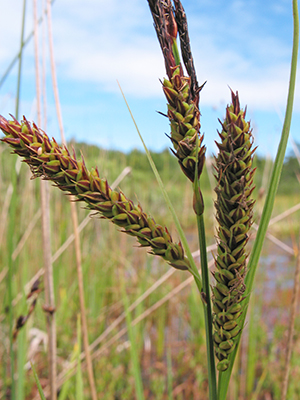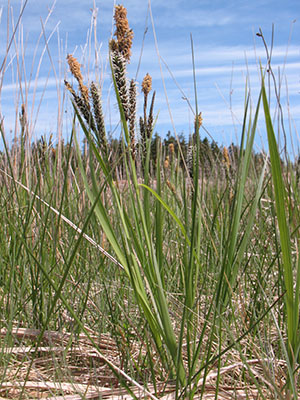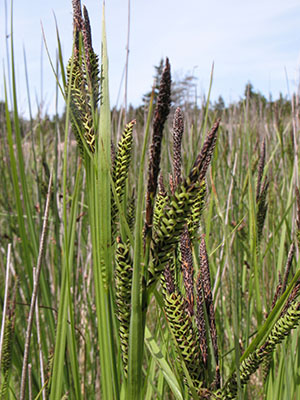DACF Home → Bureaus & Programs → Maine Natural Areas Program → Communities, Plants, and Animals → Rare Plants → Carex vacillans
 Photo by Marilee Lovit
Photo by Marilee Lovit
Carex vacillans Drej. ex Hartman
Brackish Sedge
- State Rank: S2
- Global Rank: GNR
- State Status: Endangered
Habitat: Saline, brackish shores, swales, salt and intertidal marshes. [Tidal wetland (non-forested wetland)]
Range: Maritime provinces and Quebec south to Massachusetts. Also in Scandinavia.
Aids to Identification: Members of this genus can be difficult to identify without careful examination of microscopic features and knowledge of general groups of species. Carex vacillans is a member of the section Phacocystis, a group recognized by its beakless perigynia on peduncled spikes (sometimes appearing sessile). Carex vacillans has erect spikes and perigynia with a short awn. Carex vacillans is often confused with the hybrid sedge, Carex paleacea × stricta, which has more elongated spikes, fairly wide, brown colored carpellate scale midribs (as opposed to the narrower, dark-brown to purple brown midribs of C. vacillans), and lower leaf sheaths that have ladder-like shapes of thread-like fibers across the front (ladder-fibrillose). Carex vacillans can also be confused with C. recta, a rare species that has been overreported in Maine. Carex vacillans has conspicuously nerved perigynia with dense papillae on the surface and achenes that are dull and weakly invaginated. Carex recta has short papillae, inconspicuously nerved perigynia, and strongly invaginated achenes.
Ecological characteristics: Possibly of hybrid origin between Carex. nigra and C. paleacea. Known only from saltmarshes in Maine.
Phenology: Fruiting in June through August.
Family: Cyperaceae
Synonyms: Carex × super-goodenoughii (Kükenth.) Lepage
Known Distribution in Maine: This rare plant has been documented from a total of 4 towns in the following county(ies): Hancock, Washington.
Reason(s) for rarity: Restricted range, scarcity of suitable habitat.
Conservation considerations: Disturbances to salt marshes could be detrimental to populations.
 Photo by Marilee Lovit
Photo by Marilee Lovit
 Photo by Marilee Lovit
Photo by Marilee Lovit
 Photo by Marilee Lovit
Photo by Marilee Lovit